Real-Scale Experimental Evaluation of Energy and Thermal Regulation Effects of PCM-Based Mortars in Lightweight Constructions
Abstract
:1. Introduction
2. Background
3. Materials and Methods
- Design and fundamental research of the PCM solutions, including selection of PCM temperature ranges, lab testing of microstructural, mechanical, and thermal characteristics, as well as preliminary numerical studies. The specific activities and results derived from this phase were reported by the authors in previous research papers [19,43].
- PCM incorporation in 1 real-scale test cell out of the 2 depicted in Figure 1. The second test cell was taken as a reference for benchmarking.
- Monitoring campaign where 2 PCMs (i.e., CrodaTherm [10] and Micronal [11]) embedded into mortar solutions were alternatively studied considering both a free-floating temperature mode (i.e., no space conditioning system activated) and a conditioned mode (i.e., PCM supporting the active operation of the space conditioning system). Winter, summer, and mid-seasons were covered by the monitoring phase.
- Analysis of the monitoring results and evaluation.
3.1. Description of the Lightweight Test Cells
- Façades: sandwich panel with 8 cm of thermal insulation (polyurethane foam) with U-value = 0.287 W/(m2·K);
- Roof: metallic roof with 16 cm of thermal insulation (mineral wool) in the internal surface presenting a U-value = 0.242 W/(m2·K);
- Floor: vinyl-based without thermal insulation and ventilated underneath.
- Openings: both test-cells have a sliding double-glazed window (U-value = 3.137 W/(m2·K) and Solar Heat Gain Coefficient (SHCG) = 0.762) and an opaque door (U-value = 0.747 W/(m2·K)), both facing South.
3.2. Monitoring Equipment
- Head Equipment—iLON SmartServer: it acts as a central data logger as well as a communication gateway between Lonworks and TCP/IP.
- Wattmeter for electrical energy use measurement. NICO 8108 LON: This equipment has a total of 8 measurement channels, of which only 2 of them are occupied for measuring the electrical energy use of the HVAC units and the total electrical energy use of the corresponding test cell.
- PLC—Distech ECL 400: it is used as an analog input module for the heat flux meters and the temperature probes. This PLC equipment has the advantage of being programmable for the most suitable monitoring strategy to the study intended.
- Amplifier (mV-V), which measures the signal from the heat flux meters and adapts it to allow the PLC equipment to read it.
- Power Source (24Vcc) required for power supply to the PLC and the multi-sensor (indoor temperature, relative humidity, and CO2 concentration) device.
- Surface temperature probes: Distech PDCSY-TT-351-A-5M. They are NTC 10K thermistors with an operating range between −10 °C and 100 °C.
- Multisensor probes: WRF04 CO2 RH LON. They are composed of an internal temperature sensor, a relative humidity (RH) sensor, and a CO2 sensor. The ranges of each sensor are as follows: Measuring range: Temperature: 0–50 °C; RH: 0–100% RH non-condensing; CO2: 0–2000 ppm.
- Heat flux meters: HUKEFLUX HFP01. They were connected to the analog inputs of the PLC, which must be previously programmed to be able to adjust the precision, the measurement tolerance, as well as the voltage reading range. In order for the PLC to interpret the voltage signal introduced by the heat flux meter, the connection of an amplifier was required thus as to increase the voltage of the signal.
- Power meter: a 60 A clamp was connected to a NICO 8108L power meter in order to measure the electricity consumption of the HVAC units. The meter accuracy reported by the manufacturer is: ±1% fs (50/60 Hz) for voltage and current measurements; ±1.5% fs for active power.
3.3. Experimental Test Setups
- Free-floating temperature mode: in these periods the air conditioning units of both test cells were turned off, thus the corresponding surface and room air temperatures evolved freely as a result of the cell energy balance accounting for wall transmission loads, infiltrations, solar irradiation through the windows and the specific thermal inertia of the constructions. No upper or lower bounds in the evolution of the indoor air temperatures were imposed.
- Conditioned mode: in these periods the indoor environment at each test cell was controlled by the air conditinioning units. Particularly, a setpoint of 25 °C was fixed to control the indoor room temperature, thus imposing an upper bound to its evolution during cooling operation, while modifying the natural energy balance with the additional heat supply to reach the setpoint during heating operation. The electricity use of the conditioning equipment was monitored continuously in order to detect differences between the reference cell and the target cell (with PCM-based mortar applied).
4. Results
4.1. Thermal Response under Free-Floating Temperature Conditions
4.2. Impacts on the Energy Use of the Conditioning Equipment
5. Discussion of Main Findings and Implications
6. Conclusions and Future Work
- The monitoring results revealed a reduction in indoor thermal fluctuations with significant expression during summer and shoulder seasons. The selected PCM configurations contribute to reducing indoor temperature peaks by 1–2 °C in such periods.
- Due to the selected PCM phase change temperatures (close to the higher limit of the thermal comfort zone), the impact of the two PCM-containing mortars on the indoor thermal behavior under free-floating mode operation remained unnoticed during the winter season.
- A 5–10% reduction on the energy consumption of the air-conditioning equipment was observed during the monitoring campaign.
- This trend was observed both during winter and summer months under controlled-temperature (conditioned mode) operation because the targeted indoor comfort conditions intersected the phase change range of the selected PCMs and triggered their partial activation (which did not happen under free-floating temperature mode).
Author Contributions
Funding
Data Availability Statement
Conflicts of Interest
Abbreviations
| % fs | Sensor accuracy expressed as a % of full scale |
| CAGR | Compound Annual Growth Rate |
| DX | Direct Expansion |
| HVAC | Heating, Ventilation and Air Conditioning |
| KET | Key Enabling Technology |
| PCM | Phase Change Material |
| RH | Relative Humidity |
| SHGC | Solar Heat Gain Coefficient |
| TABS | Thermally Activated Building Systems |
References
- Building Performance Institute of Europe (BPIE). Underpinning the Role of One-Stop Shops in the EU Renovation Wave: First Lessons Learned from the Turnkey Retrofit Replication. Available online: https://www.bpie.eu/wp-content/uploads/2021/11/Turnkey-Retrofit-report_OneStopShops_RenovationWave_Final.pdf (accessed on 2 December 2021).
- Building Performance Institute of Europe (BPIE). Deep Renovation: Shifting from Exception to Standard Practice in EU Policy. Available online: https://www.bpie.eu/wp-content/uploads/2021/11/BPIE_Deep-Renovation-Briefing_Final.pdf (accessed on 2 December 2021).
- COM (2020) 562 Final—Stepping Up Europe’s 2030 Climate Ambition Communication. Available online: https://eur-lex.europa.eu/legal-content/EN/TXT/HTML/?uri=CELEX:52020DC0562from=EN (accessed on 2 December 2021).
- COM (2020) 662 Final—A Renovation Wave for Europe—Greening Our Buildings, Creating Jobs, Improving Lives. Available online: https://eur-lex.europa.eu/legal-content/EN/TXT/HTML/?uri=CELEX:52020DC0662from=EN (accessed on 2 December 2021).
- Martínez, F.J.R.; Velasco Gómez, E. Eficiencia Energética en Edificios. Certificación y Auditorías Energéticas: Certificación y Auditorías Energéticas; Editorial Paraninfo: Madrid, Spain, 2006; pp. 1–234. [Google Scholar]
- Arce, P.; Medrano, M.; Gil, A.; Oró, E.; Cabeza, L.F. Overview of thermal energy storage (TES) potential energy savings and climate change mitigation in Spain and Europe. Appl. Energy 2011, 88, 2764–2774. [Google Scholar] [CrossRef]
- Olivieri, L.; Tenorio, J.A.; Revuelta, D.; Navarro, L.; Cabeza, L.F. Developing a PCM-enhanced mortar for thermally active precast walls. Constr. Build. Mater. 2018, 181, 638–649. [Google Scholar] [CrossRef]
- Da Cunha, S.R.L.; de Aguiar, J.L.B. Phase change materials and energy efficiency of buildings: A review of knowledge. J. Energy Storage 2020, 27, 101083. [Google Scholar] [CrossRef]
- Marin, P.; Saffari, M.; Gracia, A.; Zhu, X.; Farid, M.; Cabeza, L.; Ushak, S. Energy savings due to the use of PCM for relocatable lightweight buildings passive heating and cooling in different weather conditions. Energy Build. 2016, 129, 274–283. [Google Scholar] [CrossRef] [Green Version]
- CrodaThermTM ME29P Microencapsulated Ambient Temperature Phase Change Material. Material Specification. Available online: https://www.crodaenergytechnologies.com/en-gb/product-finder/product/981-Crodatherm_1_29 (accessed on 6 December 2021).
- BASF. Micronal® PCM. Intelligent Temperature Management for Buildings. Material Specification. Available online: https://www.microteklabs.com/product-data-sheets (accessed on 6 December 2021).
- Rao, V.V.; Parameshwaran, R.; Ram, V.V. PCM-mortar based construction materials for energy efficient buildings: A review on research trends. Energy Build. 2018, 158, 95–122. [Google Scholar] [CrossRef]
- Haurie, L.; Serrano, S.; Bosch, M.; Fernández, A.I.; Cabeza, L.F. Addition of microencapsulated PCM into single layer mortar: Physical and thermal properties and fire resistance. In Proceedings of the Eurotherm Seminar, University of Lleida, Lleida, Spain, 28–30 May 2014; Volume 99, pp. 1–9. [Google Scholar]
- Guardia, C.; Barluenga, G.; Palomar, I.; Diarce, G. Thermal enhanced cement-lime mortars with phase change materials (PCM), lightweight aggregate and cellulose fibers. Constr. Build. Mater. 2019, 221, 586–594. [Google Scholar] [CrossRef]
- Guardia, C.; Barluenga, G.; Palomar, I. PCM Cement-Lime Mortars for Enhanced Energy Efficiency of Multilayered Building Enclosures under Different Climatic Conditions. Materials 2020, 13, 4043. [Google Scholar] [CrossRef]
- Yeon, J.H. Thermal behavior of cement mortar embedded with low-phase transition temperature PCM. Constr. Build. Mater. 2020, 252, 119168. [Google Scholar] [CrossRef]
- Djamai, Z.I.; Salvatore, F.; Larbi, A.S.; Cai, G.; el Mankibi, M. Multiphysics analysis of effects of encapsulated phase change materials (PCMs) in cement mortars. Cem. Concr. Res. 2019, 119, 51–63. [Google Scholar] [CrossRef]
- SUDOKET Project. Available online: http://sudoket.com/ (accessed on 2 December 2021).
- Rebelo, F.; Figueiredo, A.; Vicente, R.; Ferreira, V.M. Study of a thermally enhanced mortar incorporating phase change materials for overheating reduction in buildings. J. Energy Storage 2022, 6, 103876. [Google Scholar] [CrossRef]
- Soares, N.; Santos, P.; Gervásio, H.; Costa, J.J.; da Silva, L.S. Energy efficiency and thermal performance of lightweight steel-framed (LSF) construction: A review. Renew. Sustain. Energy Rev. 2017, 78, 194–209. [Google Scholar] [CrossRef]
- Soares, N.; Gaspar, A.R.; Santos, P.; Costa, J.J. Multi-dimensional optimization of the incorporation of PCM-drywalls in lighweight steel-framed residential buildings in different climates. Energy Build. 2014, 70, 411–421. [Google Scholar] [CrossRef]
- Roque, E.; Vicente, R.; Almeida, R.M.S.F. Opportunities of Light Steel Framing towards thermal comfort in southern European climates: Long-term monitoring and comparison with the heavyweight construction. Build. Environ. 2021, 200, 107937. [Google Scholar] [CrossRef]
- Amaral, C.; Vicente, R.; Ferreira, V.M.; Silva, T. Polyurethane foams with microencapsulated phase change material: Comparative analysis of thermal conductivity characterization approaches. Energy Build. 2017, 153, 392–402. [Google Scholar] [CrossRef]
- Figueiredo, A.; Lapa, J.; Vicente, R.; Cardoso, C. Mechanical and thermal characterization of concrete with incorporation of microencapsulated PCM for applications in thermally activated slabs. Constr. Build. Mater. 2016, 112, 639–647. [Google Scholar] [CrossRef]
- Frazzica, A.; Brancato, V.; Palomba, V.; la Rosa, D.; Grungo, F.; Calabrese, L.; Proverbio, E. Thermal performance of hybrid cement mortar-PCMs for warm climates application. Sol. Energy Mater. Sol. Cells 2019, 193, 270–280. [Google Scholar] [CrossRef]
- Gracia, A.; Cabeza, L.F. Phase change materials and thermal energy storage for buildings. Energy Build. 2015, 103, 414–419. [Google Scholar] [CrossRef] [Green Version]
- Shilei, L.; Neng, Z.; Guohui, F. Impact of phase change wall room on indoor thermal environment in winter. Energy Build. 2006, 38, 18–24. [Google Scholar] [CrossRef]
- Oliver, A. Thermal characterization of gypsum boards with PCM included: Thermal energy storage in buildings through latent heat. Energy Build. 2012, 48, 1–7. [Google Scholar] [CrossRef]
- Salgueiro, T.; Samagaio, A.; Gonçalves, M.; Figueiredo, A.; Labrincha, J.; Silva, L. Incorporation of phase change materials in an expanded clay containing mortar for indoor thermal regulation of buildings. J. Energy Storage 2021, 36, 102385. [Google Scholar] [CrossRef]
- Navarro, L.; de Gracia, A.; Castell, A.; Álvarez, S.; Cabeza, L.F. PCM incorporation in a concrete core slab as a thermal storage and supply system: Proof of concept. Energy Build. 2015, 103, 70–82. [Google Scholar] [CrossRef] [Green Version]
- Cabeza, L.F.; Castellón, C.; Nogués, M.; Medrano, M.; Leppers, R.; Zubillaga, O. Use of microencapsulated PCM in concrete walls for energy savings. Energy Build. 2007, 39, 113–119. [Google Scholar] [CrossRef]
- Silva, T.; Vicente, R.; Soares, N.; Ferreira, V. Experimental testing and numerical modelling of masonry wall solution with PCM incorporation: A passive construction solution. Energy Build. 2012, 49, 235–245. [Google Scholar] [CrossRef]
- Vicente, R.; Silva, T. Brick masonry walls with PCM macrocapsules: An experimental approach. Appl. Therm. Eng. 2014, 67, 24–34. [Google Scholar] [CrossRef]
- Muraleedharan, M.; Nadir, Y. Geopolymer mortar integrated with phase change materials for improvement of thermal efficiency in buildings: A review. Mater. Today Proc. 2020, 44, 878–885. [Google Scholar] [CrossRef]
- Chou, H.-M.; Chen, C.-R.; Nguyen, V.-L. A new design of metal-sheet cool roof using PCM. Energy Build. 2013, 57, 42–50. [Google Scholar] [CrossRef]
- Amaral, C.; Pinto, S.C.; Silva, T.; Mohseni, F.; Amaral, J.S.; Amaral, V.S.; Marques, P.A.A.P.; Barros-Timmons, A.; Vicente, R. Development of polyurethane foam incorporating phase change material for thermal energy storage. J. Energy Storage 2020, 28, 101177. [Google Scholar] [CrossRef]
- Silva, T.; Vicente, R.; Rodrigues, F. Literature review on the use of phase change materials in glazing and shading solutions. Renew. Sustain. Energy Rev. 2016, 53, 515–535. [Google Scholar] [CrossRef]
- Cunha, S.; Aguiar, J.B.; Tadeu, A. Thermal performance and cost analysis of mortars made with PCM and different binders. Constr. Build. Mater. 2016, 122, 637–648. [Google Scholar] [CrossRef]
- Cunha, S.; Leite, P.; Aguiar, J. Characterization of innovative mortars with direct incorporation of phase change materials. J. Energy Storage 2020, 30, 101439. [Google Scholar] [CrossRef]
- Kheradmand, M.; Azenha, M.; de Aguiar, J.L.B.; Castro-Gomes, J. Experimental and numerical studies of hybrid PCM embedded in plastering mortar for enhanced thermal behaviour of buildings. Energy 2016, 94, 250–261. [Google Scholar] [CrossRef] [Green Version]
- Lucas, S.S.; Ferreira, V.M.; de Aguiar, J.L.B. Latent heat storage in PCM containing mortars—Study of microstructural modifications. Energy Build. 2013, 66, 724–731. [Google Scholar] [CrossRef] [Green Version]
- Kheradmand, M.; Azenha, M.; de Aguiar, J.L.B.; Krakowiak, K.J. Thermal behavior of cement based plastering mortar containing hybrid microencapsulated phase change materials. Energy Build. 2014, 84, 526–536. [Google Scholar] [CrossRef]
- Rebelo, F.; Corredera, A.; Andrés, M.; Vicente, R.; Morentin, F.; Ferreira, V.M.; Bujedo, L.A. Análisis del efecto de materiales de cambio de fase sobre la demanda de calefacción en una casa fotovoltaica. In CIES2020-XVII Congresso Ibérico e XIII Congresso Ibero-Americano de Energia Solar; LNEG-Laboratório Nacional de Energia e Geología: Lisbon, Portugal, 2020; pp. 761–768. [Google Scholar]
- Mordor Intelligence. European Prefabricated Buildings Market—Growth, Trends, COVID-19 Impact, and Forecasts (2022–2027). Available online: https://www.mordorintelligence.com/industry-reports/european-prefabricated-buildings-industry-study (accessed on 12 December 2021).
- ReportLinker. Prefabricated Building Market in Europe—Industry Outlook and Forecast (2021–2026). Available online: https://www.reportlinker.com/p06063356/Prefabricated-Building-Market-in-Europe-Industry-Outlook-and-Forecast.html?utm_source=GNW (accessed on 12 December 2021).
- Roland Berger. Prefabricated Housing Market in Central and Northern Europe—Overview of Market Trends and Development. Available online: https://www.rolandberger.com/en/Insights/Publications/Prefabricated-housing-market.html (accessed on 12 December 2021).
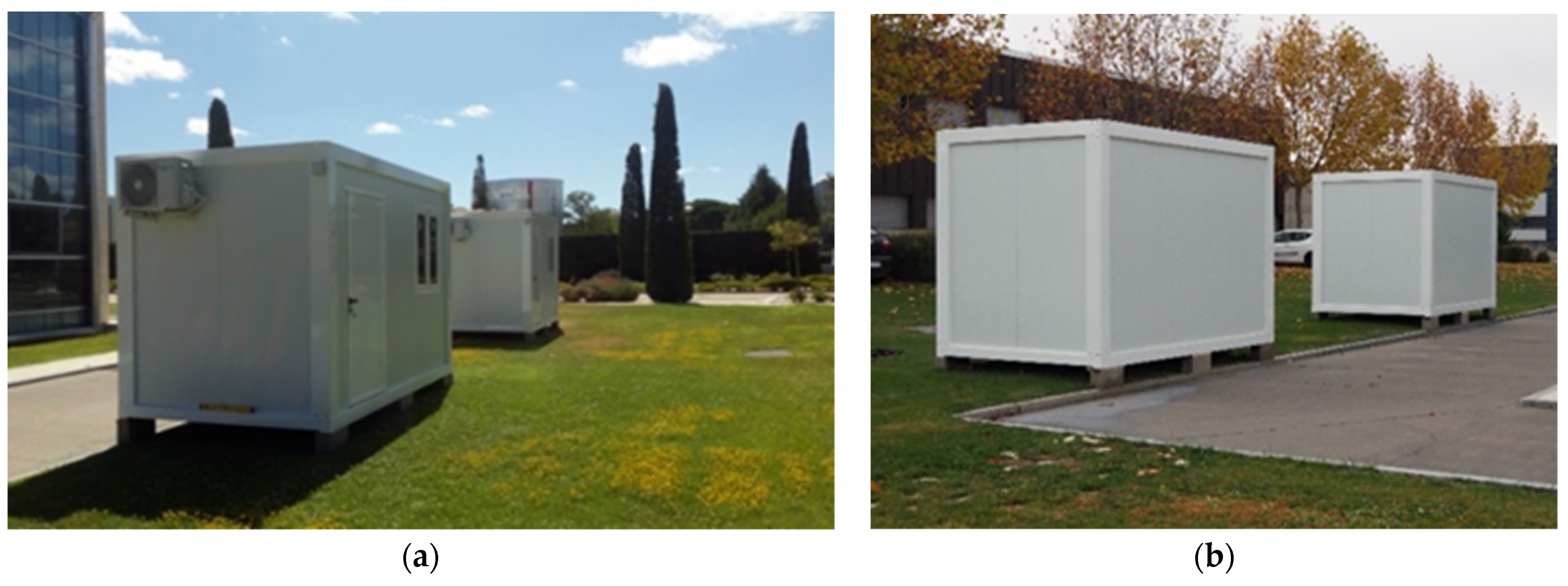
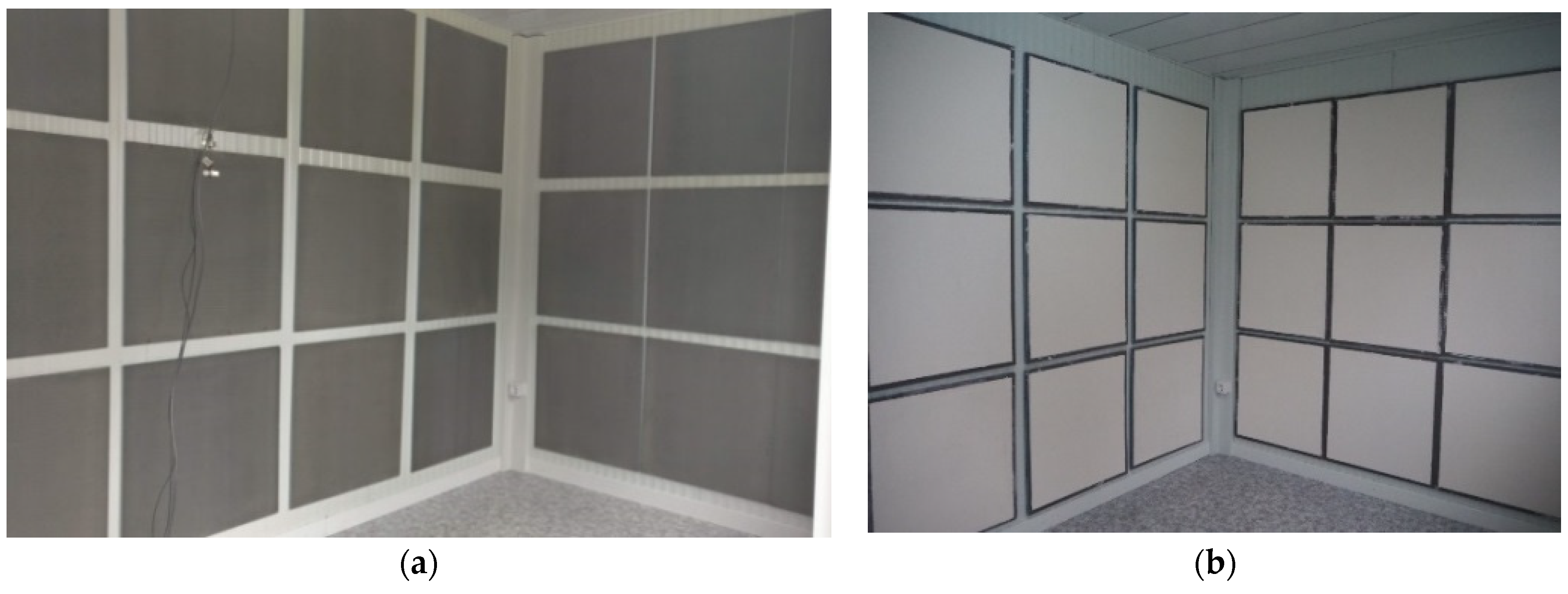


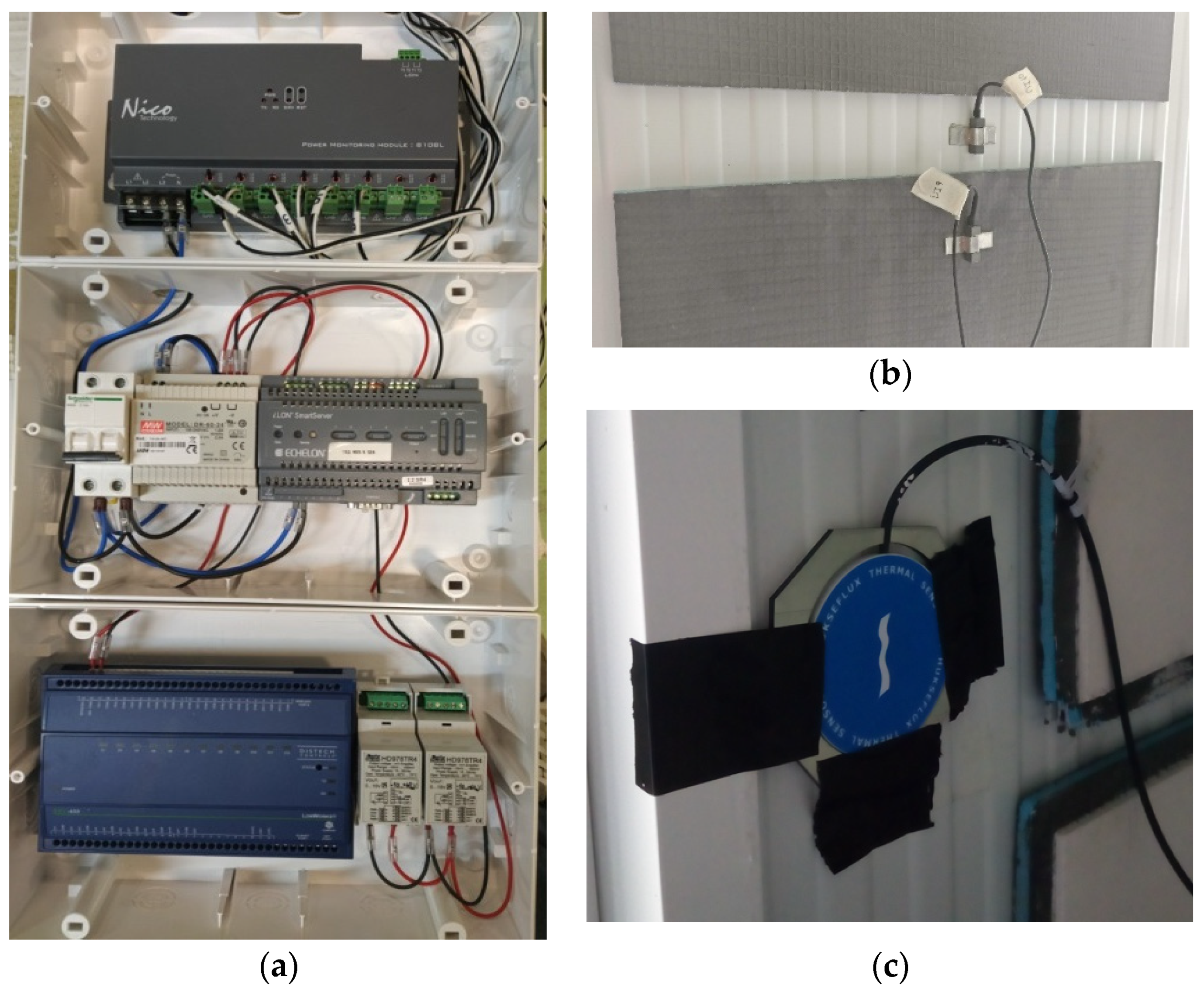


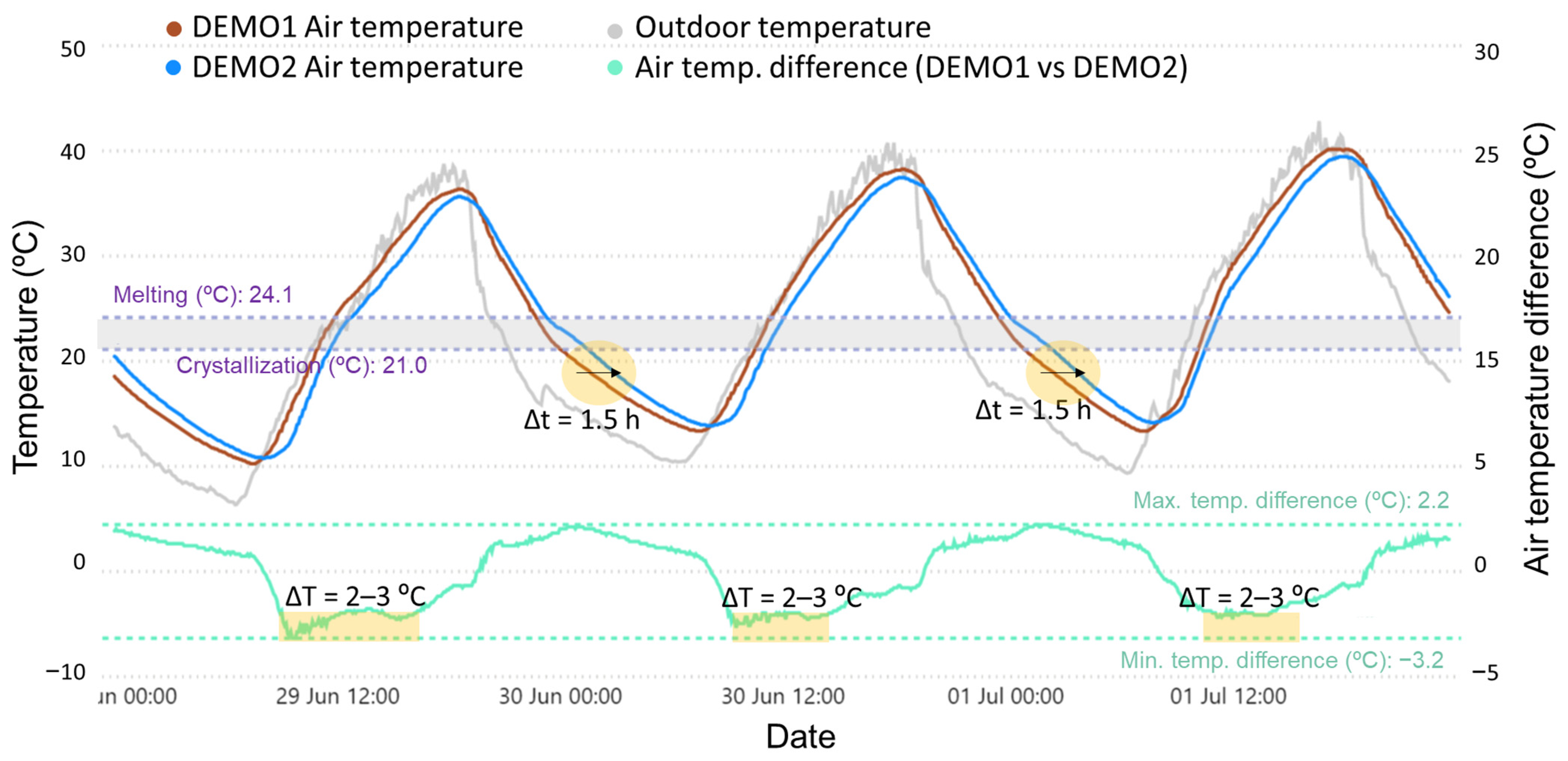
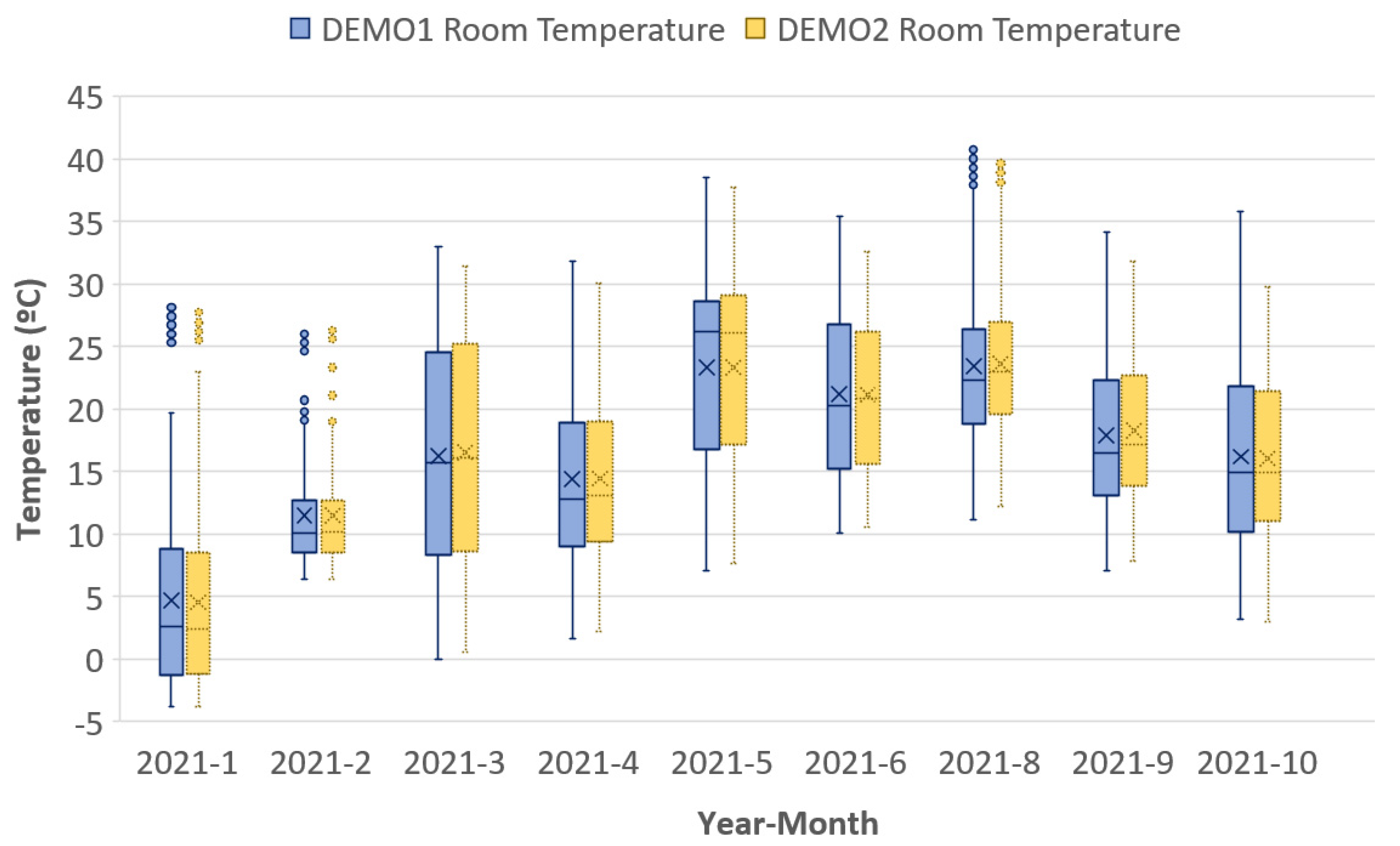
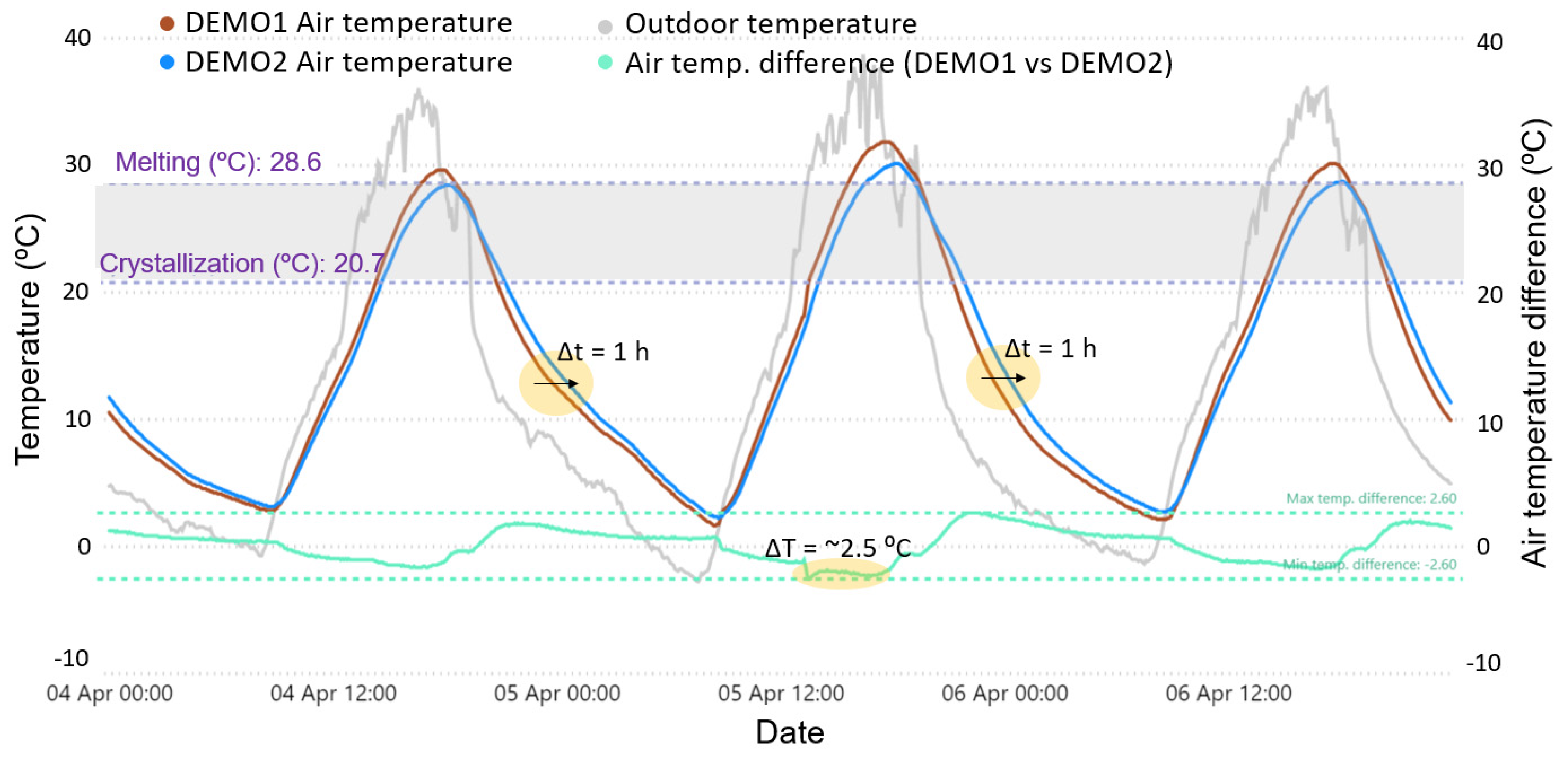
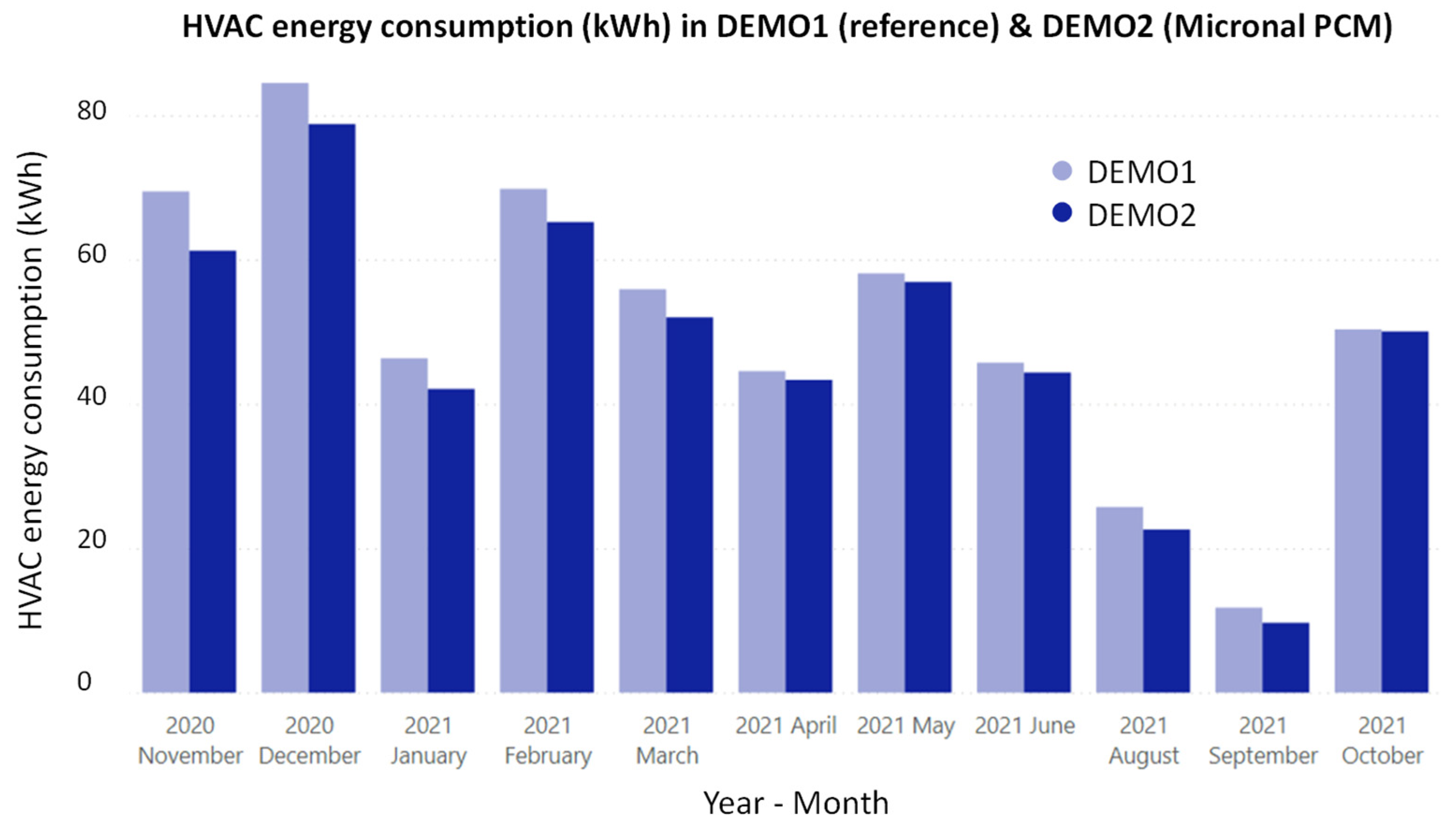
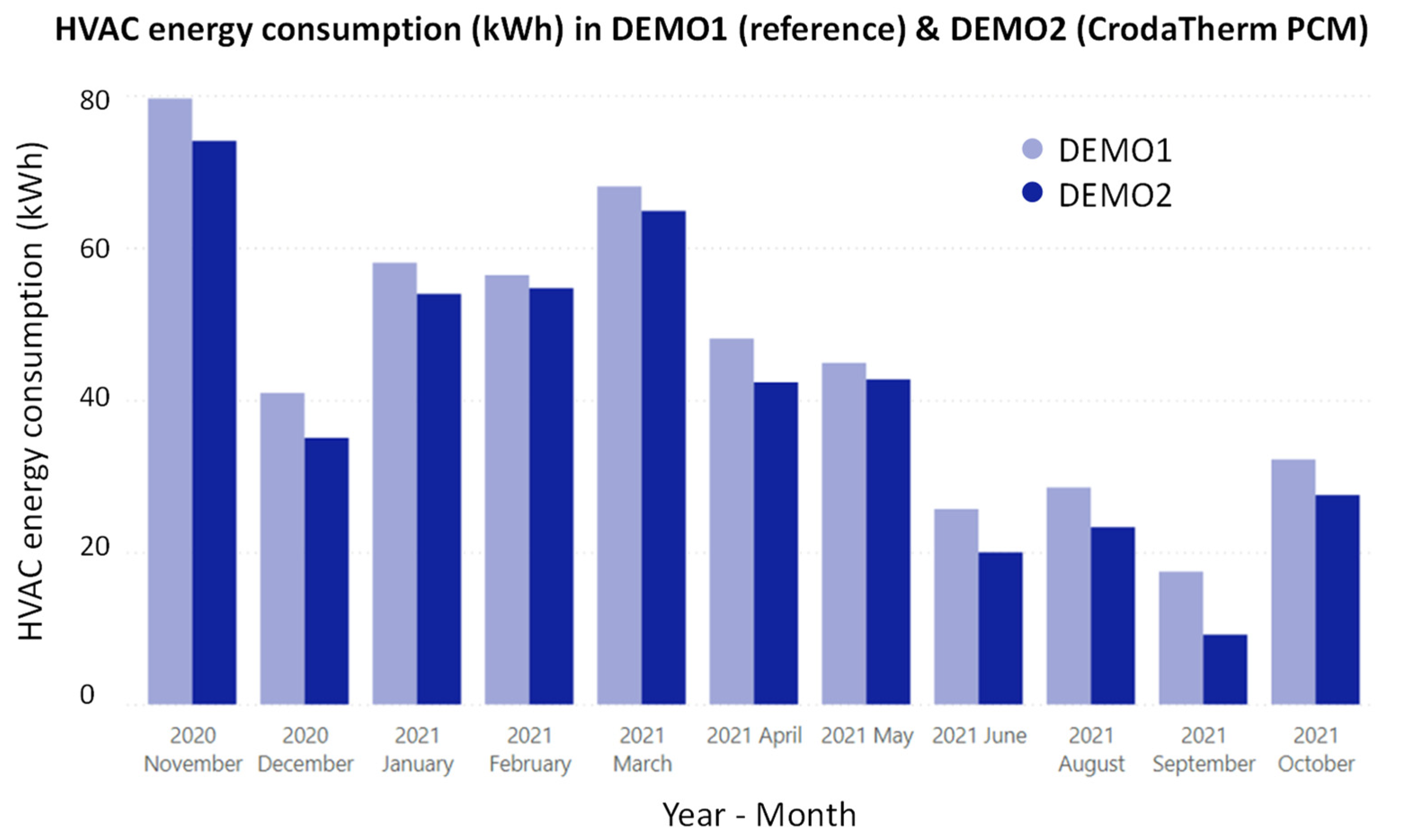
| Total Applied PCM Mass [kg] | Mortar (Mixture) Density [kg/m3] | Phase Change Temperatures [°C] | Latent Heat [kJ/kg] | |
|---|---|---|---|---|
| Micronal | 10.4 | 1034 | Melting: 24.1 Crystallization: 21.06 | Charge: 110 Discharge: 110 |
| CrodaTherm | 11.32 | 1322 | Melting: 28.55 Crystallization: 20.74 | Charge: 183 Discharge: 179 |
| Variable | Units |
|---|---|
| Heat flux through the Northern façade | W/m2 |
| Heat flux through the Southern façade | W/m2 |
| Indoor room temperature | °C |
| Internal wall surface temperature at the Northern façade | °C |
| Internal wall surface temperature at the Southern façade | °C |
| External wall surface temperature at the Northern façade | °C |
| External wall surface temperature at the Southern façade | °C |
| Internal coating * surface temperature placed on the Northern façade | °C |
| Internal coating * surface temperature placed on the Southern façade | °C |
| Ceiling surface temperature | °C |
| Floor surface temperature | °C |
| Internal window surface temperature | °C |
| Electric current from total electricity | A |
| Electric current from air conditioning electricity | A |
| Total electricity | kWh |
| Air conditioning electricity | kWh |
| CO2 concentration | ppm |
| Indoor room relative humidity | % |
| Date | Energy Use in DEMO1 (kWh) | Energy Use in DEMO2 (kWh) | Energy Savings (%) |
|---|---|---|---|
| November-2020 | 69.49 | 61.26 | 11.85% |
| December-2020 | 84.46 | 78.76 | 6.74% |
| January-2021 | 46.32 | 42.08 | 9.16% |
| February-2021 | 69.79 | 65.20 | 6.58% |
| March-2021 | 55.89 | 51.99 | 6.98% |
| April-2021 | 44.54 | 43.33 | 2.72% |
| May-2021 | 58.08 | 56.90 | 2.03% |
| June-2021 | 45.71 | 44.35 | 2.98% |
| August-2021 | 25.72 | 22.60 | 12.13% |
| September-2021 | 11.77 | 9.67 | 17.82% |
| October-2021 | 50.33 | 50.04 | 0.57% |
| Date | Energy Use in DEMO1 (kWh) | Energy Use in DEMO2 (kWh) | Energy Savings (%) |
|---|---|---|---|
| November-2020 | 79.61 | 74.03 | 7.01% |
| December-2020 | 40.93 | 35.02 | 14.43% |
| January-2021 | 58.03 | 53.94 | 7.05% |
| February-2021 | 56.42 | 54.69 | 3.07% |
| March-2021 | 68.06 | 64.84 | 4.73% |
| April-2021 | 48.07 | 42.33 | 11.94% |
| May-2021 | 44.87 | 42.71 | 4.81% |
| June-2021 | 25.67 | 19.99 | 22.14% |
| August-2021 | 28.50 | 23.28 | 18.32% |
| September-2021 | 17.45 | 9.17 | 47.47% |
| October-2021 | 32.20 | 27.51 | 14.57% |
Publisher’s Note: MDPI stays neutral with regard to jurisdictional claims in published maps and institutional affiliations. |
© 2022 by the authors. Licensee MDPI, Basel, Switzerland. This article is an open access article distributed under the terms and conditions of the Creative Commons Attribution (CC BY) license (https://creativecommons.org/licenses/by/4.0/).
Share and Cite
Andrés, M.; Rebelo, F.; Corredera, Á.; Figueiredo, A.; Hernández, J.L.; Ferreira, V.M.; Bujedo, L.A.; Vicente, R.; Morentin, F.; Samaniego, J. Real-Scale Experimental Evaluation of Energy and Thermal Regulation Effects of PCM-Based Mortars in Lightweight Constructions. Appl. Sci. 2022, 12, 2091. https://doi.org/10.3390/app12042091
Andrés M, Rebelo F, Corredera Á, Figueiredo A, Hernández JL, Ferreira VM, Bujedo LA, Vicente R, Morentin F, Samaniego J. Real-Scale Experimental Evaluation of Energy and Thermal Regulation Effects of PCM-Based Mortars in Lightweight Constructions. Applied Sciences. 2022; 12(4):2091. https://doi.org/10.3390/app12042091
Chicago/Turabian StyleAndrés, Manuel, Filipe Rebelo, Álvaro Corredera, António Figueiredo, José L. Hernández, Víctor M. Ferreira, Luis A. Bujedo, Romeu Vicente, Francisco Morentin, and Jesús Samaniego. 2022. "Real-Scale Experimental Evaluation of Energy and Thermal Regulation Effects of PCM-Based Mortars in Lightweight Constructions" Applied Sciences 12, no. 4: 2091. https://doi.org/10.3390/app12042091
APA StyleAndrés, M., Rebelo, F., Corredera, Á., Figueiredo, A., Hernández, J. L., Ferreira, V. M., Bujedo, L. A., Vicente, R., Morentin, F., & Samaniego, J. (2022). Real-Scale Experimental Evaluation of Energy and Thermal Regulation Effects of PCM-Based Mortars in Lightweight Constructions. Applied Sciences, 12(4), 2091. https://doi.org/10.3390/app12042091










